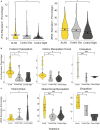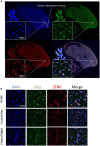Dim artificial light at night alters immediate early gene expression throughout the avian brain
- PMID: 37469841
- PMCID: PMC10352805
- DOI: 10.3389/fnins.2023.1194996
Dim artificial light at night alters immediate early gene expression throughout the avian brain
Abstract
Artificial light at night (ALAN) is a pervasive pollutant that alters physiology and behavior. However, the underlying mechanisms triggering these alterations are unknown, as previous work shows that dim levels of ALAN may have a masking effect, bypassing the central clock. Light stimulates neuronal activity in numerous brain regions which could in turn activate downstream effectors regulating physiological response. In the present study, taking advantage of immediate early gene (IEG) expression as a proxy for neuronal activity, we determined the brain regions activated in response to ALAN. We exposed zebra finches to dim ALAN (1.5 lux) and analyzed 24 regions throughout the brain. We found that the overall expression of two different IEGs, cFos and ZENK, in birds exposed to ALAN were significantly different from birds inactive at night. Additionally, we found that ALAN-exposed birds had significantly different IEG expression from birds inactive at night and active during the day in several brain areas associated with vision, movement, learning and memory, pain processing, and hormone regulation. These results give insight into the mechanistic pathways responding to ALAN that underlie downstream, well-documented behavioral and physiological changes.
Keywords: Taeniopygia guttata; ZENK; cFos; light pollution; zebra finch.
Copyright © 2023 Hui, Chen, Chakraborty, Alaasam, Pieraut and Ouyang.
Conflict of interest statement
The authors declare that the research was conducted in the absence of any commercial or financial relationships that could be construed as a potential conflict of interest.
Figures



Similar articles
-
Effects of dim artificial light at night on locomotor activity, cardiovascular physiology, and circadian clock genes in a diurnal songbird.Environ Pollut. 2021 Aug 1;282:117036. doi: 10.1016/j.envpol.2021.117036. Epub 2021 Mar 31. Environ Pollut. 2021. PMID: 33838441 Free PMC article.
-
Artificial Light at Night Increases Recruitment of New Neurons and Differentially Affects Various Brain Regions in Female Zebra Finches.Int J Mol Sci. 2020 Aug 26;21(17):6140. doi: 10.3390/ijms21176140. Int J Mol Sci. 2020. PMID: 32858878 Free PMC article.
-
Evidence That Artificial Light at Night Induces Structure-Specific Changes in Brain Plasticity in a Diurnal Bird.Biomolecules. 2021 Jul 21;11(8):1069. doi: 10.3390/biom11081069. Biomolecules. 2021. PMID: 34439736 Free PMC article.
-
Artificial light at night affects brain plasticity and melatonin in birds.Neurosci Lett. 2020 Jan 18;716:134639. doi: 10.1016/j.neulet.2019.134639. Epub 2019 Nov 21. Neurosci Lett. 2020. PMID: 31760086
-
Endocrine effects of exposure to artificial light at night: A review and synthesis of knowledge gaps.Mol Cell Endocrinol. 2023 Jun 1;568-569:111927. doi: 10.1016/j.mce.2023.111927. Epub 2023 Apr 3. Mol Cell Endocrinol. 2023. PMID: 37019171 Review.
Cited by
-
Dimly illuminated nights alter behavior and negatively affect fat metabolism in adult male zebra finches.Photochem Photobiol Sci. 2024 Dec;23(12):2201-2210. doi: 10.1007/s43630-024-00659-7. Epub 2024 Nov 15. Photochem Photobiol Sci. 2024. PMID: 39546189
-
Light at night exposure and risk of dementia conversion from mild cognitive impairment in a Northern Italy population.Int J Health Geogr. 2024 Nov 23;23(1):25. doi: 10.1186/s12942-024-00384-5. Int J Health Geogr. 2024. PMID: 39580439 Free PMC article.
-
Coping with light pollution in urban environments: Patterns and challenges.iScience. 2024 Feb 16;27(3):109244. doi: 10.1016/j.isci.2024.109244. eCollection 2024 Mar 15. iScience. 2024. PMID: 38433890 Free PMC article. Review.
-
Artificial light and neurodegeneration: does light pollution impact the development of Alzheimer's disease?Geroscience. 2024 Feb;46(1):87-97. doi: 10.1007/s11357-023-00932-0. Epub 2023 Sep 21. Geroscience. 2024. PMID: 37733222 Free PMC article. Review.
References
-
- Alaasam V. J., Liu X., Niu Y., Habibian J. S., Pieraut S., Ferguson B. S., et al. . (2021). Effects of dim artificial light at night on locomotor activity, cardiovascular physiology, and circadian clock genes in a diurnal songbird. Environ. Pollut. 282:117036. doi: 10.1016/j.envpol.2021.117036, PMID: - DOI - PMC - PubMed
Grants and funding
LinkOut - more resources
Full Text Sources
Other Literature Sources

